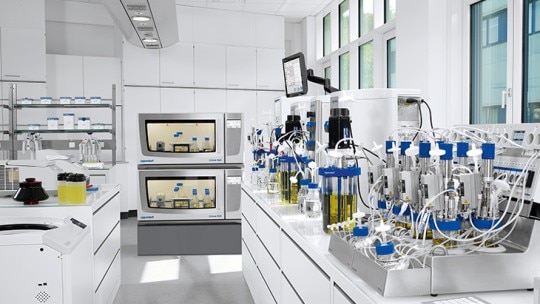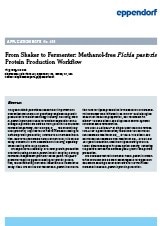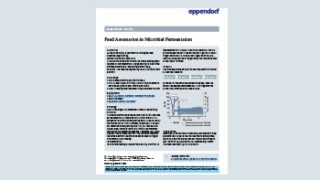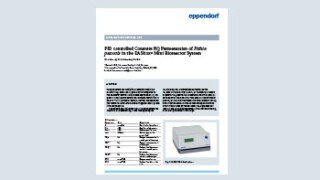MENU
LT | EUR
LT | EUR
You are about to leave this site.
Please be aware that your current cart is not saved yet and cannot be restored on the new site nor when you come back. If you want to save your cart please login in into your account.
myEppendorf
No results found
Search Suggestions
GMP info
Regarding suitability of Eppendorf bioprocess equipment in GMP-regulated applications, please reach out to your Eppendorf sales representative.
Yeast Fermentation
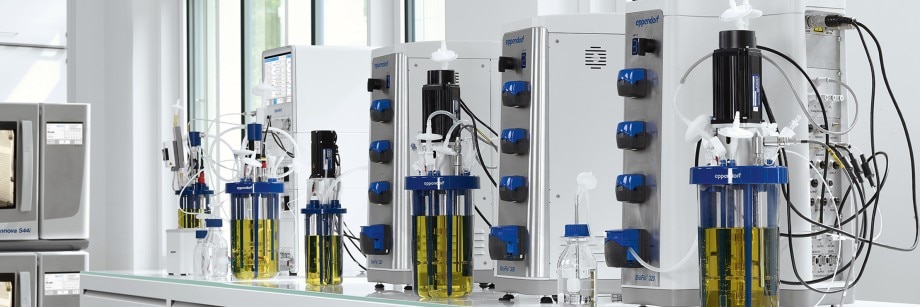
Advantages of yeast fermentation in the biopharmaceutical industry
What is yeast fermentation? When thinking of yeast fermentation in bioprocessing, food, ethanol and biofuel production may come to mind. However, yeast is a versatile microorganism that is also widely used in the biopharmaceutical industry, for the expression of recombinant proteins to prevent or treat diseases. Industry-relevant yeast species include Saccharomyces cerevisiae and Pichia pastoris.
Yeast fermentation is well suited for the large-scale production of therapeutic proteins, due to:
Microorganisms including and yeast are ideal for large-scale bioprocessing due to their high yields and fast growth. However, an advantage of yeast cells in particular is that they are eukaryotic and so they are more comparable to human cells. Consequently, yeast cells can perform a range of post-translational protein modifications that bacteria are unable to. These modifications are essential for the functioning of therapeutic proteins and include glycosylation, protein folding and phosphorylation.
Yeast fermentation is well suited for the large-scale production of therapeutic proteins, due to:
- Fast growth rate
- Easy genetic manipulation
- High cell productivity
- Ability to be grown at high cell densities
- High tolerance to deviations in pH and temperature (compared to mammalian cells)
- Cheaper costs and shorter cultivation cycles than mammalian cell cultures
Microorganisms including and yeast are ideal for large-scale bioprocessing due to their high yields and fast growth. However, an advantage of yeast cells in particular is that they are eukaryotic and so they are more comparable to human cells. Consequently, yeast cells can perform a range of post-translational protein modifications that bacteria are unable to. These modifications are essential for the functioning of therapeutic proteins and include glycosylation, protein folding and phosphorylation.
Read more
Read less
What properties make a bioreactor system suitable for microbial production?
Find out, which bioreactor features can support achieving high cell densities, simplify scale-up, and streamline bioprocess optimization.
Read more
Read less
Pichia pastoris fermentation: Basic information
Pichia pastoris is a popular species for yeast fermentation in the large-scale production of recombinant proteins. This yeast species is capable of achieving high cell densities and protein yields, and is also easy to scale up, demonstrating high levels of reproducibility in small-scale, through to bench-scale and production-scale bioprocesses. In shakers or bioreactors of any size, Pichia pastoris can be used as a powerful protein expression system.
Read more
Read less
Optimizing protein expression in yeast fermentation
Developing a commercially viable yeast fermentation process requires the optimization product yields. An adequate supply of nutrients must be ensured, to support high cell densities. The promoter system is another important factor that determines protein expression. Here we will have a look at some factors that can contribute to the optimization of protein expression in yeast.
Read more
Read less
Methanol-free induction of protein expression in Pichia pastoris
For protein expression in Pichia pastoris, traditionally, the AOX1 promoter is used that requires the presence of methanol for its activation. Concerns of methanol have been raised due to its toxicity and flammability, resulting in a need to move away from the use of methanol in yeast fermentation.To overcome this, other Pichia pastoris promoters such as PUPP can function in the presence of other carbon sources including glycercol. These promoters have enabled the development of safer methanol-free Pichia pastoris expression systems. Learn how to set up methanol-free Pichia pastoris bioprocessing systems!
Read more
Read less
Choosing between batch, fed-batch, and continuous fermentation
The operation mode of a yeast culture relates to the strategy of feed addition, and is an important consideration for yields and productivity. Read more how choosing between fatch fermentation, fed-batch fermentation and continuous culture can be used to optimize your bioprocess.
Read more
Read less
Bioreactor systems for yeast fermentation from 60 mL to 2,400 L
Eppendorf bioreactor systems demonstrate robust and scalable fermentation across several applications, including the use of Pichia pastoris cultures for biologics production.
- Scalability from 60 mL to 2,400 L
- Used in combination with BioBLU® f Single-Use Bioreactors , glass bioreactors, or sterilize-in-place bioreactors
- Comprehensive bioprocess monitoring and control through DASware® control and BioCommand® bioprocess control software
